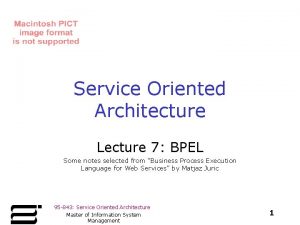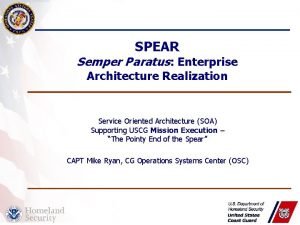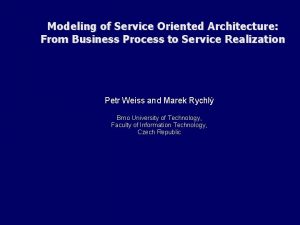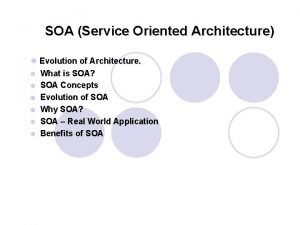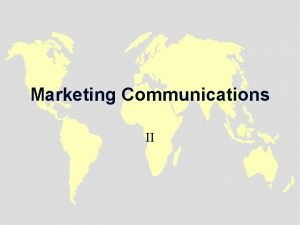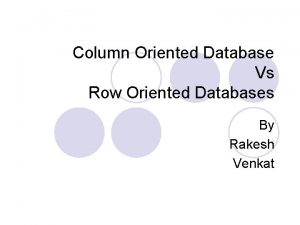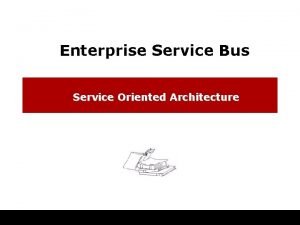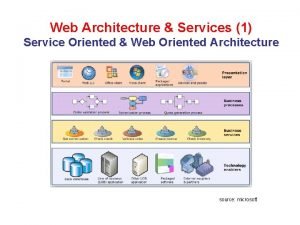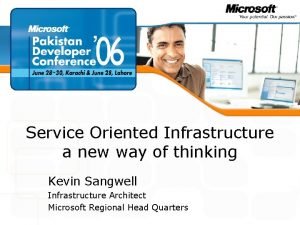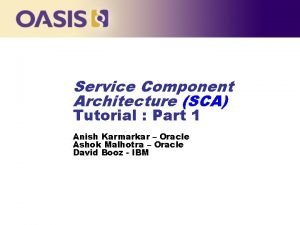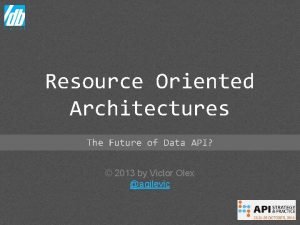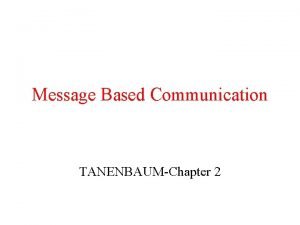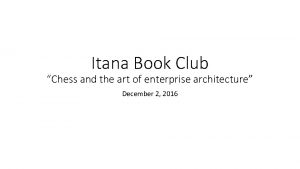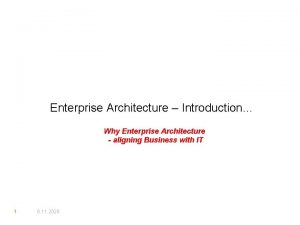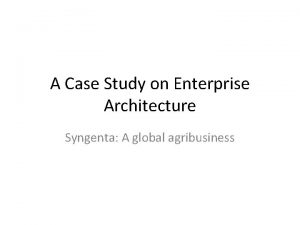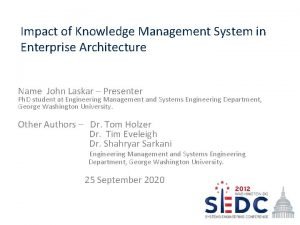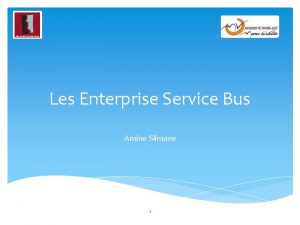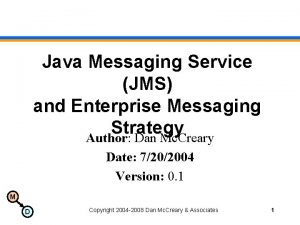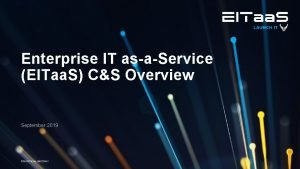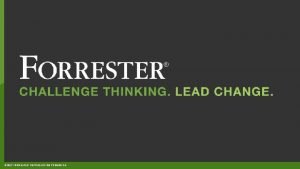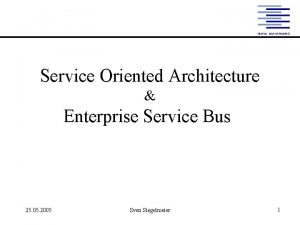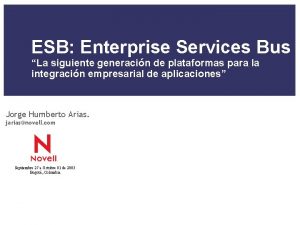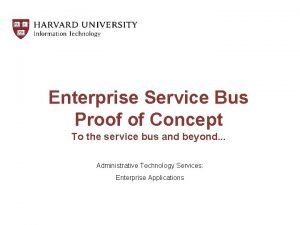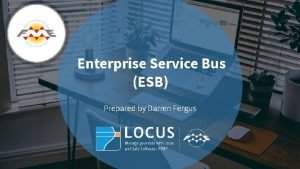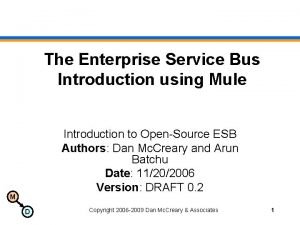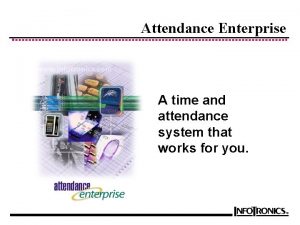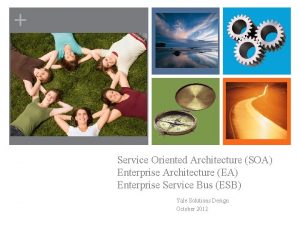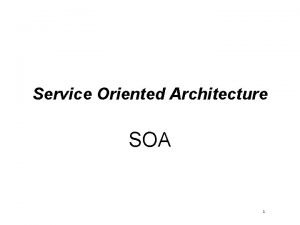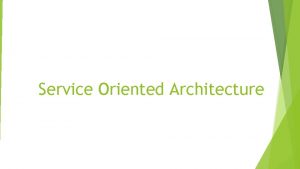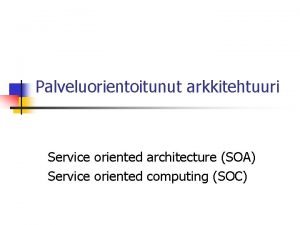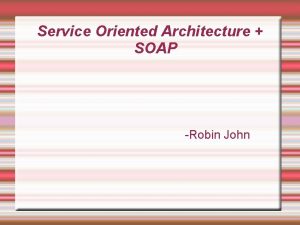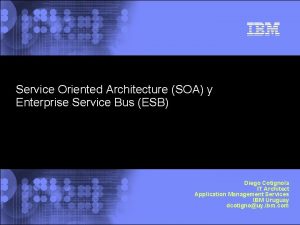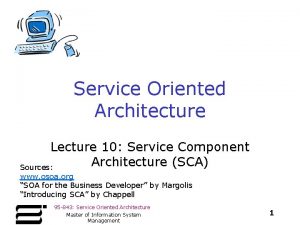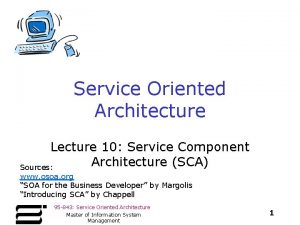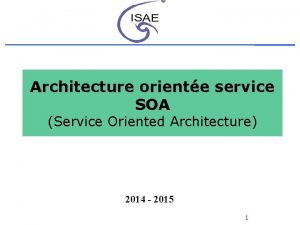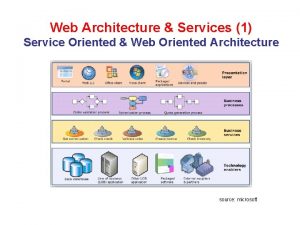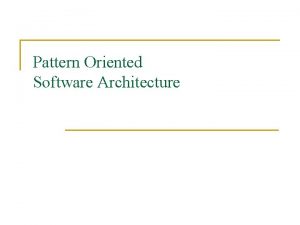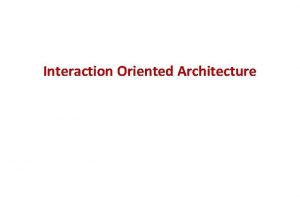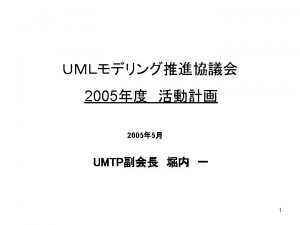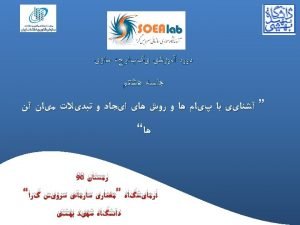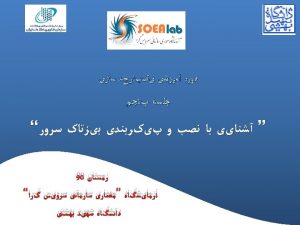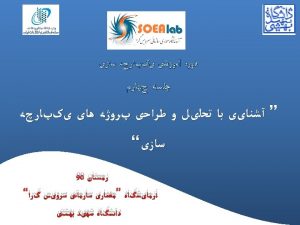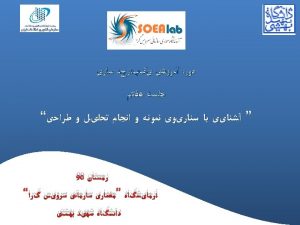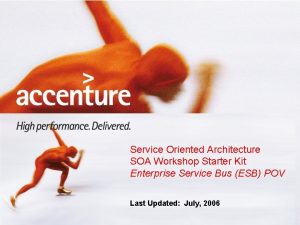Enterprise Architecture and Service Oriented Architecture The Way












































- Slides: 44

Enterprise Architecture and Service Oriented Architecture: The Way To Effective and Efficient E-Libya Dr. Farag M. Sallabi Directorate General of Electronic Services Ministry of Communications and Informatics Libya Interim Government

Outline United Nations 2012 E-Government Survey E-Government Concepts and Enablers E-Libya Strategy Development Enterprise Architecture Service Oriented Architecture Conclusions

United Nations E-Government Survey 2012: Overall Conclusion Governments must increasingly begin to rethink in terms of egovernment and e-governance placing greater emphasis on institutional linkages between and among the tiered government structures in a bid to create synergy for inclusive sustainable development. This approach is to widen the scope of e-government for a transformative role of the government towards cohesive, coordinated, and integrated processes and institutions through which sustainable development takes place. Member States have begun to move from a decentralized single-purpose organization model of e-government to an integrated unified whole-ofgovernment model for the people. This approach supports the strengthening of institutional linkages with interconnected departments and divisions; greater efficiency and effectiveness of governance systems; and better public service delivery”

World E-Government Development Leaders 2012 Rank 1 2 3 4 5 6 7 8 9 10 11 12 13 14 15 16 17 18 19 20 Country Republic of Korea Netherlands United Kingdom Denmark United States France Sweden Norway Finland Singapore Canada Australia New Zealand Liechtenstein Switzerland Israel Germany Japan Luxembourg Estonia E-Government Development Index 0. 9283 0. 9125 0. 896 0. 8889 0. 8687 0. 8635 0. 8599 0. 8593 0. 8505 0. 8474 0. 843 0. 839 0. 8381 0. 8264 0. 8134 0. 81 0. 8079 0. 8014 0. 7987 United Nations E-Government Survey 2012

Emerging Leaders in E-Government Development Austria Iceland Spain Belgium Slovenia Monaco Russian Federation United Arab Emirates Lithuania Croatia Hungary Italy Portugal Ireland Malta Bahrain Greece Kazakhstan Chile Malaysia Saudi Arabia Latvia Colombia Barbados Cyprus 0 0, 1 0, 2 0, 3 0, 4 0, 5 0, 6 0, 784 0, 7835 0, 77700000001 0, 77180000001 0, 74920000001 0, 74680000002 0, 7345 0, 7344 0, 7333 0, 73280000002 0, 72010000001 0, 71900000001 0, 7165 0, 71490000001 0, 71310000001 0, 69460000003 0, 68720000002 0, 68440000001 0, 67690000002 0, 67030000002 0, 66580000002 0, 66040000001 0, 65720000002 0, 65660000002 0, 65080000002 0, 7 0, 8 0, 9 United Nations E-Government Survey 2012

Regional Averages in E-Government Development 0, 278 Africa 0, 5403 Americas Asia 0, 4992 0, 71880000002 Europe 0, 424 Oceania World Average 0, 4882 0 0, 1 0, 2 0, 3 0, 4 0, 5 0, 6 0, 7 0, 8 United Nations E-Government Survey 2012

Top Ranked Countries in Africa E-Government World E-Government development index development Ranking Rank 1 2 3 4 5 6 7 8 9 10 Country Seychelles Mauritius South Africa Tunisia Egypt Cape Verde Kenya Morocco Botswana Namibia 2012 0. 5192 0. 5066 0. 4869 0. 4833 0. 4611 0. 4297 0. 4212 0. 4209 0. 4186 0. 3937 2010 0. 4179 0. 4645 0. 4306 0. 4826 0. 4518 0. 4054 0. 3338 0. 3287 0. 3637 0. 3314 2012 84 93 101 103 107 118 119 120 121 123 2010 104 77 97 66 86 108 124 126 117 125 United Nations E-Government Survey 2012

E-Government Development in Northern Africa E-Government development index Country World E-Government development Ranking 2012 2010 Tunisia Egypt Morocco Algeria Sudan South Sudan Libya 0. 4833 0. 4611 0. 4209 0. 3608 0. 261 0. 2239 N/A 0. 4826 0. 4518 0. 3287 0. 3181 0. 2542 N/A 0. 3799 103 107 120 132 165 175 N/A 66 86 126 131 154 N/A 114 Sub Regional Average 0. 3159 0. 3692 World Average 0. 4882 0. 4406 United Nations E-Government Survey 2012

E-Government Concept E-Government Delivery Models E-Government Applications • Integrative effective use of all information and communication technologies, to facilitate and accelerate transactions with high accuracy within government agencies. • • • G 2 C (Government to Citizens) G 2 B (Government to Businesses) G 2 E (Government to Employees) G 2 G (Government to Governments) C 2 G (Citizens to Governments) • Applications deployed in all government agencies (typical applications), such as: personnel systems, financial systems, filing systems, and others. • Applications shared between a number of government agencies, as a labor recruitment requests. • Applications specific to government agency.

Enablers of E-Government 20% Technology 20% (Must be selected carefully) Technology 40% Change Management 80% People Process 35% Process Reengineering 5% Luck Subhash Bhatnagar Advisor e. Government, ISGIA, World Bank, Washington DC Adjunct Professor Indian Institute of Management, Ahmedabad

Non-Functional Requirements : Ignored Functionality Reliability Efficiency Portability Usability Maintainability Analyzability Testability Changeability Maintainability Stability Reference: IEC 25010 Security

E-Government: Ten Lessons Learned from the Best Global Programs 1 Lesson 1: Ensure clear senior leader sponsorship and strategic aims Lesson 2: Develop a comprehensive e-government strategy from the start Lesson 3: Rethink government as a service provider and focus on service modernization Lesson 4: Do not focus on Web services only; follow a multichannel approach Lesson 5: Build a solid technology platform with a set of core components across entities Lesson 6: Define an interaction model between centralized and decentralized responsibilities Lesson 7: Engage in tireless and unwavering program management Lesson 8: Present success stories rapidly; share some quick wins Lesson 9: Communicate the program and benefits of e-government Lesson 10: Build in-house capacity, and don’t underestimate change management 1 - R. Bernnat, A. Johnstone-Burt, W. Zink and F. Thomé “E-Government: Ten Lessons Learned from the Best Global Programs”, Booz & Co. , 2010.

E-Libya Strategy Development

E-Libya Main Goals The use of technology to provide better services and improve the quality and level of life for citizens in Libya Increase the efficiency and effectiveness of government ministries and agencies Develop the knowledge economy and enhance the added value through the development of human resources, and promotion of the private sector

Potential Benefits Creating new operational processes and changing current processes Ensuring that all citizens will have equal access Increased accountability Increased transparency Higher availability of public domain information Higher performance Reduced corruption Higher penetration due to automation Helps boost the private sector Allows for decentralization of governance and Services Reduce Government costs

Overview of E-Libya Initiative Libya National Strategic Directions E-Libya Initiative 1 Use Of Technology to Deliver Services • Integrated and scalable Government ICT Infrastructure supporting reliable delivery of government services for e. Government, e. Commerce, e. Health, and e. Education • Decentralization of government services, accessible from everywhere 2 Increased Efficiency & Effectiveness of Government Services Develop Libya Knowledge 3 Economy and Private Sector Participation • Open Government providing electronic services across multiple channels creating participative environment between citizens, businesses, and government • Government process modernization and open data supported by robust legal framework fostering usage of electronic transactions • ICT Capability building programs for government employees , business and citizen community • Foster participation of ICT private sector to build and deliver IT projects. • Institutionalize e. Government programs and collaboration with education institutions

E-Libya Roadmap 2013 2018

Tentative E-Libya Framework E-Libya Rules and Regulations National ID Card E-Portal and other access channels Utilities Justice Financial HR Education Health Social Army Trade Islamic Affairs Internal Affairs Housing Vehicle Travel Tax Voting Integration IT Security Government Network Data Center

Libyan Government Network - Example

To-Be E-Government Services Architecture

Enterprise Architecture

Key Definitions Enterprise Any collection of organizations that has a common set of goals. For example, an enterprise could be a government agency, a whole corporation, a division of a corporation, a single department, or a chain of geographically distant organizations linked together by common ownership. Architecture ISO/IEC 42010: 20077 defines architecture as: “The fundamental organization of a system, embodied in its components, their relationships to each other and the environment, and the principles governing its design and evolution. ” Enterprise Architecture A strategic information asset base, which defines the mission, the information necessary to perform the mission and the technologies necessary to perform the mission, and the transitional processes for implementing new technologies in response to the changing mission needs. An enterprise architecture includes a baseline architecture, target architecture, and a sequencing plan.

Benefits of Enterprise Architecture Create a more efficient IT Operations Better return on existing investment, reduced risk for future investments Faster, simpler and cheaper procurement • Lower software development, support and maintenance costs • Increased portability of applications • Improved interoperability and easier system and network management • Improved ability to address critical enterprise-wide issues like security • Easier upgrade and exchange of system components • Reduced complexity in IT infrastructure • Maximum return on investment in existing IT infrastructure • Reduced risk overall in new investment, and the costs of IT ownership • Buying decisions are simpler, because the information governing procurement is readily available in a coherent plan • The procurement process is faster

Some Enterprise Architecture Methods TOGAF ZACHMAN FEAF DODAF

TOGAF for E-Libya: Why? � TOGAF, an Open Group Standard. � A proven enterprise architecture methodology and framework used by the world's leading organizations to improve business efficiency. � The most prominent and reliable enterprise architecture standard, ensuring consistent standards, methods, and communication among enterprise architecture professionals. � Enterprise architecture professionals fluent in TOGAF standards enjoy greater industry credibility, job effectiveness, and career opportunities. � TOGAF helps practitioners avoid being locked into proprietary methods, utilize resources more efficiently and effectively, and realize a greater return on investment.

Types of architecture domains Enterprise Architecture Business Architecture How the business is organised to met its objectives IT Architecture Information Systems or Applications Architecture Data Architecture Technology Architecture How the information System support the objective of the business Structure of the data assets How the technology fits together

® TOGAF 9 Components

The Architecture Development Method � The core of TOGAF � A proven way of developing an architecture � Specifically designed to address business requirements � An iterative method � A set of architecture views to ensure that a complex set of requirements are adequately addressed

Prepare the organization for a successful architecture project ADM Phases Provide continual monitoring and a change management process to ensure that the architecture responds to the needs of the enterprise Provide architectural oversight for the implementation; ensure that the implementation project conforms to the architecture Analyze costs, benefits and risks; develop detailed Implementation and Migration Plan Ensure that every stage of a TOGAF project is based on and validates business requirements Set the scope, constraints and expectations for a TOGAF project; create the Architecture Vision; validate the business context; create the Statement of Architecture Work Develop Business Architecture Develop baseline and target architectures and analyze the gaps Develop Information Systems Architectures Develop baseline and target architectures and analyze the gaps Develop Technology Architecture Develop baseline and target architectures and analyze the gaps Perform initial implementation planning; identify major implementation projects

ADM Phase Steps Example

Stand-alone or Complementary ITIL - IT Service Management Best Practice Zachman Framework COBIT Governance and control Do. D Architecture Framework Modeling languages and notation TOGAF 9 Federal Enterprise Architecture Framework

Service Oriented Architecture

What is Service Oriented Architecture (SOA)? Definition Service Orientation is a specific way of organizing capabilities into a set of discrete but linked services of measurable value that can be managed individually and collectively. It’s a thought process and a business philosophy for identifying and decomposing the business and identifying the common process characteristics that can be shared from one process to the next. How the Business Views it. . A connected set of services that business wants to expose to internal or external customers or partners, or potentially outsource to service providers (Service Oriented Business Application-SOBA). How IT Views it. . An architectural style that requires a service provider, a service requestor, and a service description It also incorporates specific characteristics such as reusability, loose coupling, composability. How Turn Key Solution Providers see it. . A framework complete with standards, tools and patterns (Pw. C’s MAGNA CARTA, Oracle SOA Suite, IBM Websphere stack, etc).

Why SOA? SOA came about to provide a solution for a number of business and technical requirements including: 1 Interoperability SOA provides increased enterprise interoperability allowing for software programs and systems to interact and exchange data. SOA provides increased federation within the IT environments to unify disparate environments while allowing those environments to be independently governed. 2 Federation 3 Business & Technology Alignment SOA allows the IT Environment within an organization to evolve with the business needs and according to business changes. 4 Organization Agility SOA increases IT responsiveness allowing it to react and adapt to business change quickly and more efficiently. 5 Existing IT Investments & Reduce IT Burden 6 Vendor Diversification SOA helps maintain and reuse existing IT investments and reduce IT overall burden (reduce redundancy, reduce size & operation cost, reduce governance and evolution, etc. ) SOA permits for refractoring or extending parts of the enterprise with new vendor technologies / products while allowing for interoperability.

SOA Enables Seamless Integration Between Heterogeneous Systems Service Consumers SOA Integration Capabilities Service Providers 1 Linking applications with different message formats (EDI / SOAP) Business App SOAP Business App Msg Data Format Transformation 2 Linking applications with different protocols (HTTP / JMS) HTTP Business App Msg Business App Protocol Transformation 3 Linking applications with different technologies EDI JMS Java Application Adapters Providing Accessibility to Databases Business App Database Adapters Providing Accessibility to Legacy Applications Mobile Application Wrapping 4 5 x. DBC Database C++ App / Legacy

SOA Basic Architecture Any application used as part of a Business process Business applications Business Apps SOA components Core infrastructure Business Apps Registry Service Broker Workflow Engine Supervisor Enterprise Service Bus Network SOA is inherently flexible in terms of how it is implemented, but these are four basic components that are central to the concept Some people confuse SOA and ESB is not actually critical for SOA, but will normally be present in companies looking to utilise SOA

SOA – How it fits together End to end business process – A purchase to pay invoice processing system which needs to validate delegation of authority approval limits via the HR system. SOA Registry 2 Purchase to pay application Broker 1 Invoice Processing 4 Message (ESB) HR application 3 Delegation Of Authority 1. Invoice processing system sends a request to service broker 2. Service broker connects to the registry to search for a service 3. Service broker then connects the invoice processing application to the Do. A application (by passing a description of the Do. A application back to the Invoice processing application). They can then connect directly 4. Once connected they can communicate with each other using messages until the service is completed Source: Pw. C analysis

Services: the building blocks of any SOA computing platform • A Service is the most fundamental unit of service oriented logic. • A service comprises a stand-alone unit of functionality available only via a formally defined interface. • Service oriented solution are typically comprised of multiple services that form a service composition. • A unit of solution logic is classified as a service when “service orientation” has been applied to a meaningful extent. The eight service orientation design principles: 1 Standardized Service Contract 1 and policy Service Loose Coupling 2 Governance 3 Service Abstraction Service A 4 Service Reusability o Capability A 5 Service Autonomy o Capability B 6 Service Statelessness 7 Service Discoverability 8 Service Composability o Capability C

SOA: Layers of Services Consumer Applications Business process services Composite services Basic services Existing applications

Example: Expanded as a Conceptual Enterprise Architecture

Dimensions of SOA Governance People. The governance organizational structure must be well defined by creating centralized groups that are given the authority to enforce key governance policies, processes and activities. To facilitate this, businesses should implement a detailed responsibility, accountability, contribution, informed (RACI) chart that clearly delineates who is responsible for what. Moreover, a strong leadership and executive sponsorship is essential to implement your organization’s SOA initiative. Process. A robust SOA governance structure will create well-defined issue reporting, conflict resolution, escalation, analysis and approval processes to guard against decentralized SOA projects getting out of control. Technology. Finally, it’s essential to automate as many of the governance processes as possible, including creating repositories for common SOA artifacts such as architecture and design documents and registries for services and their metadata.

Potential SOA Initiative Goals Typically, a SOA initiative could be driven by some of the following needs: • • Need to unify or consolidate the communication mechanisms used by applications Need to Standardize the implementation of business logic Need to increase the flexibility of business processes Need to gradually remove or replace legacy systems Need to hide the duplication of systems due to a merger Need to create pure SOA applications And many more…

Six different Approaches to Implement SOA Short iterations Long iterations Bottom up Starting with a few applications and move upwards Starting with many applications and move upwards Top down Starting with a few business processes and move downwards Starting with many business processes and move downwards Outside in Starting with a few business processes and a few applications and move inwards Starting with many business processes and many applications and move inwards

Conclusions E-Government • Is not a hype • Is not e-business • E-government systems are IS • E-government systems sits within a broader context Most E-Government Projects Fail • System never implemented • System implemented but immediately abandoned • Major goals for the system are not attained • Undesirable outcomes Only Minority of E-Government Projects Succeed • Clear vision • Clear strategy • Sustained upper administration support • Proper management • User education and awareness
 Service oriented architecture notes
Service oriented architecture notes Characteristics of service oriented architecture
Characteristics of service oriented architecture Service oriented architecture franchise
Service oriented architecture franchise Service oriented architecture diagram
Service oriented architecture diagram Soa l
Soa l Service oriented architecture soap
Service oriented architecture soap Microsoft service oriented architecture
Microsoft service oriented architecture Trade-oriented sales promotion
Trade-oriented sales promotion Row oriented database
Row oriented database Enterprise service bus
Enterprise service bus One way table and two way table
One way table and two way table Difference between binary tree and threaded binary tree
Difference between binary tree and threaded binary tree Beda one way anova dan two way anova
Beda one way anova dan two way anova Principles of conventional software engineering
Principles of conventional software engineering Putting the enterprise into the enterprise system
Putting the enterprise into the enterprise system Enterprise
Enterprise Web-oriented architecture
Web-oriented architecture Service oriented infrastructure
Service oriented infrastructure Service oriented architechture
Service oriented architechture Two way anova
Two way anova What does one way anova tell you
What does one way anova tell you One way anova vs two way anova
One way anova vs two way anova Contoh soal uji two way anova
Contoh soal uji two way anova Bottle of rum to fill my tum
Bottle of rum to fill my tum Talk this way
Talk this way Resource oriented architecture
Resource oriented architecture Message-oriented communication definition
Message-oriented communication definition Chess and the art of enterprise architecture
Chess and the art of enterprise architecture Enterprise architecture principles
Enterprise architecture principles Enterprise architecture case study
Enterprise architecture case study Enterprise architecture knowledge management
Enterprise architecture knowledge management Service desk single point of contact
Service desk single point of contact Amine slimane
Amine slimane Jms in java
Jms in java Enterprise it as a service air force
Enterprise it as a service air force Enterprise service management forrester
Enterprise service management forrester Planung enterprise service bus
Planung enterprise service bus Mom esb
Mom esb Aws enterprise service bus
Aws enterprise service bus Fme system caller
Fme system caller Mule enterprise service bus
Mule enterprise service bus Enterprise time and attendance
Enterprise time and attendance Attendance enterprise employee self service
Attendance enterprise employee self service Hát kết hợp bộ gõ cơ thể
Hát kết hợp bộ gõ cơ thể Frameset trong html5
Frameset trong html5
